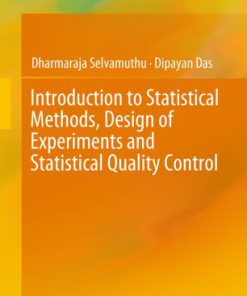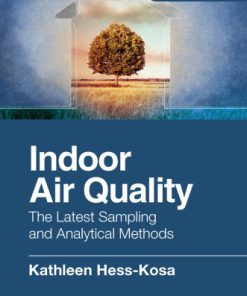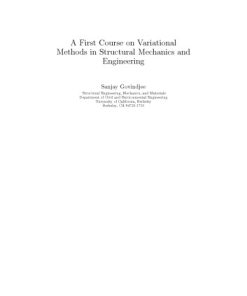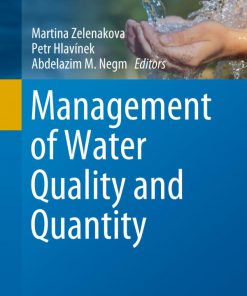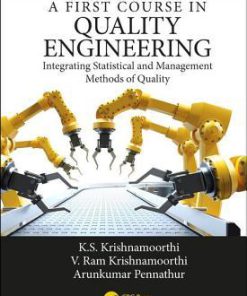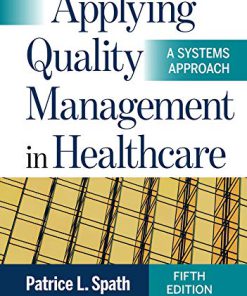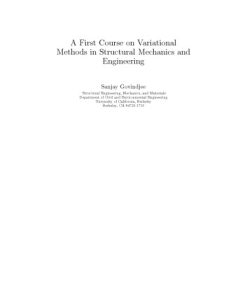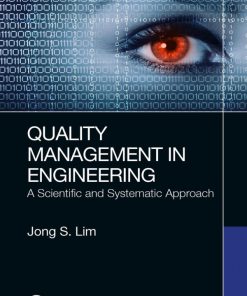A First Course in Quality Engineering Integrating Statistical and Management Methods of Quality 3rd Edition by Krishnamoorthi 9781498764230 1498764231
$50.00 Original price was: $50.00.$25.00Current price is: $25.00.
A First Course in Quality Engineering Integrating Statistical and Management Methods of Quality 3rd Edition by Krishnamoorthi – Ebook PDF Instant Download/Delivery: 9781498764230, 1498764231
Full download A First Course in Quality Engineering Integrating Statistical and Management Methods of Quality 3rd Edition after payment
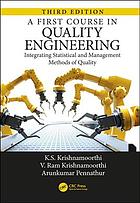
Product details:
• ISBN 10:1498764231
• ISBN 13:9781498764230
• Author:Krishnamoorthi
A First Course in Quality Engineering
Integrating Statistical and Management Methods of Quality
This book is the leader among the new generation of text books on quality that follow the systems approach to creating quality in products and services; the earlier generations focused solely on parts of the system such as statistical methods, process control, and management philosophy. It follows the premise that the body of knowledge and tools documented by quality professionals and researchers, when employed in designing, creating and delivering the product will lead to product quality, customer satisfaction and reduced waste. The tools employed at the different stages of the product creation cycle are covered in this book using real world examples along with their theoretical bases, strengths and weaknesses. This textbook can be used for training – from shop floor personnel to college majors in business and engineering to practicing professionals. Graduate students training as researchers in the quality field will also find useful material. The book has been used as the text for a Professional Series Massive Open Online Course offered by the Technical University of Munich on edX.org, through which tens of thousands of participants from all over the world have received training in quality methods. According to Professor Dr. Holly Ott, who chose the book for the course, the text is one of the main factors contributing to success of this MOOC. The Third Edition has been fully revised to be friendly for self-study, reflects changes in the standards referenced such as ISO 9000, and includes new examples of application of statistical tools in health care industry. Features: Reviews the history of quality movement in the U.S. and abroad Discusses Quality Cost analysis and quality’s impact on a company’s bottom line Explains finding customer needs and designing the product using House of Quality Covers selection of product parameters using DOE and reliability principles Includes control charts to control processes to make the product right-the-first-time Describes use of capability indices Cp and Cpk to meet customer needs Presents problem solving methodology and tools for continuous improvement Offers ISO 9000, Baldrige and Six Sigma as templates for creating a quality system
A First Course in Quality Engineering Integrating Statistical and Management Methods of Quality 3rd Table of contents:
Chapter 1 Introduction to Quality
1.1 A Historical Overview
1.1.1 A Note about “Quality Engineering”
1.2 Defining Quality
1.2.1 Product Quality vs. Service Quality
1.3 The Total Quality System
1.4 Total Quality Management
1.5 Economics of Quality
1.6 Quality, Productivity, and Competitive Position
1.7 Quality Costs
1.7.1 Categories of Quality Costs
1.7.1.1 Prevention Cost
1.7.1.2 Appraisal Cost
1.7.1.3 Internal Failure Cost
1.7.1.4 External Failure Cost
1.7.2 Steps in Conducting a Quality Cost Study
1.7.3 Projects Arising from a Quality Cost Study
1.7.4 Quality Cost Scoreboard
1.7.5 Quality Costs Not Included in the TQC
1.7.6 Relationship among Quality Cost Categories
1.7.7 Summary on Quality Costs
1.7.8 A Case Study in Quality Costs
1.8 Success Stories
1.9 Exercise
1.9.1 Practice Problems
1.9.2 Mini-Projects
Mini-Project 1.1
Mini-Project 1.2
Mini-Project 1.3
Mini-Project 1.4
Chapter 2 Statistics for Quality
2.1 Variability in Populations
2.2 Some Definitions
2.2.1 The Population and a Sample
2.2.2 Two Types of Data
2.3 Quality vs. Variability
2.4 Empirical Methods for Describing Populations
2.4.1 The Frequency Distribution
2.4.1.1 The Histogram
2.4.1.2 The Cumulative Frequency Distribution
2.4.2 Numerical Methods for Describing Populations
2.4.2.1 Calculating the Average and Standard Deviation
2.4.3 Other Graphical Methods
2.4.3.1 Stem-and-Leaf Diagram
2.4.3.2 Box-and-Whisker Plot
2.4.4 Other Numerical Measures
2.4.4.1 Measures of Location
2.4.4.2 Measures of Dispersion
Summary on Empirical Methods
2.4.5 Exercises in Empirical Methods
2.5 Mathematical Models for Describing Populations
2.5.1 Probability
2.5.1.1 Definition of Probability
2.5.1.2 Computing the Probability of an Event
2.5.1.2.1 Method of Analysis
2.5.1.2.2 A Special Case
2.5.1.2.3 Method of Relative Frequency
2.5.1.3 Theorems on Probability
2.5.1.3.1 Addition Theorem of Probability
Corollary
2.5.1.3.2 The Extension of the Addition Theorem
2.5.1.3.3 Complement Theorem of Probability
2.5.1.3.4 Theorems on the Joint Occurrence of Events
2.5.1.3.5 Conditional Probability
2.5.1.3.6 Independent Events
2.5.1.3.7 The Multiplication Theorems of Probability
2.5.1.3.8 The Theorem of Total Probability
2.5.1.4 Counting the Sample Points in a Sample Space
2.5.1.4.1 The Multiplication Rule
2.5.1.4.2 Permutations
2.5.1.4.3 Theorem on Number of Permutations
2.5.1.4.4 Combinations
2.5.1.4.5 Theorem on Number of Combinations
Summary on Probability
2.5.2 Exercises in Probability
2.5.3 Probability Distributions
2.5.3.1 Random Variable
2.5.3.2 Probability Mass Function
2.5.3.3 Probability Density Function
2.5.3.4 The Cumulative Distribution Function
2.5.3.5 The Mean and Variance of a Distribution
2.5.4 Some Important Probability Distributions
2.5.4.1 The Binomial Distribution
2.5.4.1.1 The Mean and Variance of a Binomial Variable
2.5.4.2 The Poisson Distribution
2.5.4.2.1 The Mean and Variance of the Poisson Distribution
2.5.4.3 The Normal Distribution
2.5.4.3.1 The Standard Normal Distribution
2.5.4.3.2 Application of the Normal Distribution
2.5.4.4 Distribution of the Sample Average X¯
2.5.4.5 The Central Limit Theorem
Summary on Probability Distributions
2.5.5 Exercises in Probability Distributions
2.6 Inference of Population Quality from a Sample
2.6.1 Definitions
2.6.2 Confidence Intervals
2.6.2.1 CI for the µ of a Normal Population When s Is Known
2.6.2.2 Interpretation of CI
2.6.2.3 CI for µ When s Is Not Known
2.6.2.4 CI for s2 of a Normal Population
2.6.3 Hypothesis Testing
Two Types of Errors
2.6.3.1 Test Concerning the Mean µ of a Normal Population When s Is Known
2.6.3.2 Why Place the Claim Made about a Parameter in H1?
2.6.3.3 The Three Possible Alternate Hypotheses
2.6.3.4 Test Concerning the Mean µ of a Normal Population When s Is Not Known
2.6.3.5 Test for Difference of Two Means When ss Are Known
2.6.4 Tests for Normality
2.6.4.1 Use of the Normal Probability Plot
2.6.4.2 Normal Probability Plot on the Computer
2.6.4.3 A Goodness-of-Fit Test
2.6.5 The P-Value
Summary on Inference Methods
2.6.6 Exercises in Inference Methods
2.6.6.1 Confidence Intervals
2.6.6.2 Hypothesis Testing
2.6.6.3 Goodness-of-Fit Test
2.7 Mini-Projects
Mini-Project 2.1
Mini-Project 2.2
Mini-Project 2.3
Mini-Project 2.4
Chapter 3 Quality in Design
3.1 Planning for Quality
3.1.1 The Product Creation Cycle
3.2 Product Planning
3.2.1 Finding Customer Needs
3.2.1.1 Customer Survey
3.2.2 Quality Function Deployment
3.2.2.1 Customer Requirements and Design Features
3.2.2.2 Prioritizing Design Features
3.2.2.3 Choosing a Competitor as Benchmark
3.2.2.4 Targets
3.2.3 Reliability Fundamentals
3.2.3.1 Definition of Reliability
3.2.3.2 Hazard Function
3.2.3.3 The Bathtub Curve
3.2.3.4 Distribution of Product Life
3.2.3.5 The Exponential Distribution
3.2.3.6 Mean Time to Failure
3.2.3.7 Reliability Engineering
3.3 Product Design
3.3.1 Parameter Design
3.3.2 Design of Experiments
3.3.2.1 22 Factorial Design
3.3.2.2 Randomization
3.3.2.3 Experimental Results from a 22 Design
3.3.2.4 Calculating the Factor Effects
3.3.2.5 Main Effects
3.3.2.6 Interaction Effects
3.3.2.7 A Shortcut for Calculating Effects
3.3.2.8 Determining the Significance of Effects
3.3.2.9 The 23 Design
3.3.2.10 Interpretation of the Results
3.3.2.11 Model Building
3.3.2.12 Taguchi Designs
3.3.3 Tolerance Design
3.3.3.1 Traditional Approaches
3.3.3.2 Tolerancing According to Dr. Taguchi
3.3.3.3 Assembly Tolerances
3.3.3.4 The RSS Formula
3.3.3.5 Natural Tolerance Limits
3.3.4 Failure Mode and Effects Analysis
3.3.5 Concurrent Engineering
3.3.5.1 Design for Manufacturability/Assembly
3.3.5.2 Design Reviews
3.4 Process Design
3.4.1 The Process Flow Chart
3.4.2 Process Parameter Selection: Experiments
3.4.3 Floor Plan Layout
3.4.4 Process FMEA
3.4.5 Process Control Plan
3.4.6 Other Process Plans
3.4.6.1 Process Instructions
3.4.6.2 Packaging Standards
3.4.6.3 Preliminary Process Capabilities
3.4.6.4 Product and Process Validation
3.4.6.5 Process Capability Results
3.4.6.6 Measurement System Analysis
3.4.6.7 Product/Process Approval
3.4.6.8 Feedback, Assessment, and Corrective Action
3.5 Exercise
3.5.1 Practice Problems
3.5.2 Mini-Projects
Mini-Project 3.1
Mini-Project 3.2
Mini-Project 3.3
Chapter 4 Quality in Production—Process Control I
4.1 Process Control
4.2 The Control Charts
4.2.1 Typical Control Chart
4.2.2 Two Types of Data
4.3 Measurement Control Charts
4.3.1 >X¯- and R-Charts
4.3.2 A Few Notes about the X¯ and R-Charts
4.3.2.1 The Many Uses of the Charts
4.3.2.2 Selecting the Variable for Charting
4.3.2.3 Preparing Instruments
4.3.2.4 Preparing Check Sheets
4.3.2.5 False Alarm in the X¯-Chart
4.3.2.6 Determining Sample Size
4.3.2.7 Why 3-Sigma Limits?
4.3.2.8 Frequency of Sampling
4.3.2.9 Rational Subgrouping
4.3.2.10 When the Sample Size Changes for X¯- and R-Charts
4.3.2.11 Improving the Sensitivity of the X¯-Chart
4.3.2.12 Increasing the Sample Size
4.3.2.13 Use of Warning Limits
4.3.2.14 Use of Runs
4.3.2.15 Patterns in Control Charts
4.3.2.16 Control vs. Capability
4.3.3 X¯ and S-Charts
4.3.4 The Run Chart
4.4 Attribute Control Charts
4.4.1 The P-Chart
4.4.2 The C-Chart
4.4.3 Some Special Attribute Control Charts
4.4.3.1 The P-Chart with Varying Sample Sizes
4.4.3.2 The nP-Char
4.4.3.3 The Percent Defective Chart (100P-Chart)
4.4.3.4 The U-Chart
4.4.4 A Few Notes about the Attribute Control Charts
4.4.4.1 Meaning of the LCL on the P- or C-Chart
4.4.4.2 P-Chart for Many Characteristics
4.4.4.3 Use of Runs
4.4.4.4 Rational Subgrouping
4.5 Summary on Control Charts
4.5.1 Implementing SPC on Processes
4.6 Process Capability
4.6.1 Capability of a Process with Measurable Output
4.6.2 Capability Indices Cp and C pk
4.6.3 Capability of a Process with Attribute Output
4.7 Measurement System Analysis
4.7.1 Properties of Instruments
4.7.2 Measurement Standards
4.7.3 Evaluating an Instrument
4.7.3.1 Properties of a Good Instrument
4.7.3.2 Evaluation Methods
4.7.3.3 Resolution
4.7.3.4 Bias
4.7.3.5 Variability (Precision)
4.7.3.6 A Quick Check of Instrument Adequacy
4.8 Exercise
4.8.1 Practice Problems
4.8.2 Mini-Projects
Mini-Project 4.1
Mini-Project 4.2
Mini-Project 4.3
Chapter 5 Quality in Production—Process Control II
5.1 Derivation of Limits
5.1.1 Limits for the X¯-Chart
5.1.2 Limits for the R-Chart
5.1.3 Limits for the P-Chart
5.1.4 Limits for the C-Chart
5.2 Operating Characteristics of Control Charts
5.2.1 Operating Characteristics of an X¯-Chart
5.2.1.1 Computing the OC Curve of an X¯-Chart
5.2.2 OC Curve of an R-Chart
5.2.3 Average Run Length
5.2.4 OC Curve of a P-Chart
5.2.5 OC Curve of a C-Chart
5.3 Measurement Control Charts for Special Situations
5.3.1 X¯- and R-Charts When Standards for µ and/or s Are Given
5.3.1.1 Case I: µ Given, s Not Given
5.3.1.2 Case II: µ and s Given
5.3.2 Control Charts for Slow Processes
5.3.2.1 Control Chart for Individuals (X-Chart)
5.3.2.2 Moving Average and Moving Range Charts
5.3.2.3 Notes on Moving Average and Moving Range Charts
What Is a Good Value for n?
A Caution
5.3.3 The Exponentially Weighted Moving Average Chart
5.3.3.1 Limits for the EWMA Chart
5.3.4 Control Charts for Short Runs
5.3.4.1 The DNOM Chart
5.3.4.2 The Standardized DNOM Chart
5.4 Topics in Process Capability
5.4.1 The C pm Index
5.4.2 Comparison of C p?, C pk?, and C pm
5.4.3 Confidence Interval for Capability Indices
5.4.4 Motorola’s 6s Capability
5.5 Topics in the Design of Experiments
5.5.1 Analysis of Variance
5.5.2 The General 2k Design
5.5.3 The 24 Design
5.5.4 2k Design with Single Trial
5.5.5 Fractional Factorials: One-Half Fractions
5.5.5.1 Generating the One-Half Fraction
5.5.5.2 Calculating the Effects
5.5.6 Resolution of a Design
5.6 Exercise
5.6.1 Practice Problems
5.6.2 Mini-Projects
Mini-Project 5.1
Mini-Project 5.2
Chapter 6 Managing for Quality
6.1 Managing Human Resources
6.1.1 Importance of Human Resources
6.1.2 Organizations
6.1.2.1 Organization Structures
6.1.2.2 Organizational Culture
6.1.3 Quality Leadership
6.1.3.1 Characteristics of a Good Leader
6.1.4 Customer Focus
6.1.5 Open Communications
6.1.6 Empowerment
6.1.7 Education and Training
6.1.7.1 Need for Training
Necessity of Basic Skills
Global Competition
Continuous Change in Technology
Diversity in the Workplace
Need to Improve Continuously
6.1.7.2 Benefits from Training
6.1.7.3 Planning for Training
6.1.7.4 Training Methodology
6.1.7.5 Finding Resources
6.1.7.6 Evaluating Training Effectiveness
6.1.8 Teamwork
6.1.8.1 Team Building
6.1.8.2 Selecting Team Members
6.1.8.3 Defining the Team Mission
6.1.8.4 Taking Stock of the Team’s Strength
6.1.8.5 Building the Team
6.1.8.6 Basic Training for Quality Teams
6.1.8.7 Desirable Characteristics among Team Members
Trust
Selflessness
Responsibility
Enthusiasm
Initiative
Resourcefulness
Tolerance
Perseverance
6.1.8.8 Why a Team?
6.1.8.9 Ground Rules for Running a Team Meeting
6.1.8.10 Making the Teams Work
Making Team Members Know One Another
Resolving Conflicts Promptly
Setting an Example by the Organization
Rewarding Good Teams
6.1.8.11 Different Types of Teams
Process Improvement Teams
Cross-Functional Teams
Self-Managed Teams
6.1.8.12 Quality Circles
6.1.9 Motivation Methods
6.1.10 Principles of Management
6.2 Strategic Planning for Quality
6.2.1 History of Planning
6.2.2 Making the Strategic Plan
6.2.3 Strategic Plan Deployment
6.3 Exercise
6.3.1 Practice Problems
6.3.2 Mini-Project
Mini-Project 6.1
Chapter 7 Quality in Procurement
7.1 Importance of Quality in Supplies
7.2 Establishing a Good Supplier Relationship
7.2.1 Essentials of a Good Supplier Relationship
7.3 Choosing and Certifying Suppliers
7.3.1 Single vs. Multiple Suppliers
7.3.2 Choosing a Supplier
7.3.3 Certifying a Supplier
7.4 Specifying the Supplies Completely
7.5 Auditing the Supplier
7.6 Supply Chain Optimization
7.6.1 The Trilogy of Supplier Relationship
7.6.2 Planning
7.6.3 Control
7.6.4 Improvement
7.7 Using Statistical Sampling for Acceptance
7.7.1 The Need for Sampling Inspection
7.7.2 Single Sampling Plans for Attributes
7.7.2.1 The Operating Characteristic Curve
7.7.2.2 Calculating the OC Curve of a Single Sampling Plan
7.7.2.3 Designing an SSP
7.7.2.4 Choosing a Suitable OC Curve
7.7.2.5 Choosing a Single Sampling Plan
7.7.3 Double Sampling Plans for Attributes
7.7.3.1 Why Use a DSP?
7.7.3.2 The OC Curve of a DSP
7.7.4 The Average Sample Number of a Sampling Plan
7.7.5 MIL-STD-105E (ANSI Z1.4)
7.7.5.1 Selecting a Sampling Plan from MIL-STD-105E
7.7.6 Average Outgoing Quality Limit
7.7.7 Some Notes about Sampling Plans
7.7.7.1 What Is a Good AQL?
7.7.7.2 Available Choices for AQL Values in the MIL-STD-105E
7.7.7.3 A Common Misconception about Sampling Plans
7.7.7.4 Sampling Plans vs. Control Charts
7.7.7.5 Variable Sampling Plans
7.8 Exercise
Chapter 8 Continuous Improvement of Quality
8.1 The Need for Continuous Improvement
8.2 The Problem-Solving Methodology
8.2.1 Deming’s PDCA Cycle
8.2.2 Juran’s Breakthrough Sequence
8.2.3 The Generic Problem-Solving Methodology
8.3 Quality Improvement Tools
8.3.1 Cause-and-Effect Diagram
8.3.2 Brainstorming
8.3.3 Benchmarking
8.3.4 Pareto Analysis
8.3.5 Histogram
8.3.6 Control Charts
8.3.7 Scatter Plots
8.3.8 Regression Analysis
8.3.8.1 Simple Linear Regression
8.3.8.2 Model Adequacy
8.3.8.3 Test of Significance
8.3.8.4 Multiple Linear Regression
8.3.8.5 Nonlinear Regression
8.3.9 Correlation Analysis
8.3.9.1 Significance in Correlation
8.4 Lean Manufacturing
8.4.1 Quality Control
8.4.2 Quantity Control
8.4.3 Waste and Cost Control
8.4.4 Total Productive Maintenance
8.4.5 Stable, Standardized Processes
8.4.6 Visual Management
8.4.7 Leveling and Balancing
8.4.8 The Lean Culture
8.5 Exercise
8.5.1 Practice Problems
8.5.2 Term Project
Chapter 9 A System for Quality
9.1 The Systems Approach
9.2 Dr. Deming’s System
9.2.1 Long-Term Planning
Point 1: Create Constancy of Purpose for Improvement of Product and Service
9.2.2 Cultural Change
Point 2: Adopt the New Philosophy
9.2.3 Prevention Orientation
Point 3: Cease Dependence on Mass Inspection
9.2.4 Quality in Procurement
Point 4: End the Practice of Awarding Business on the Basis of Price Tag Alone
9.2.5 Continuous Improvement
Point 5: Continuously Improve the System of Production and Service
9.2.6 Training, Education, Empowerment, and Teamwork
Point 6: Institute Training
Point 7: Adopt and Institute Leadership
Point 8: Drive Out Fear
Point 9: Break Down Barriers between Staff
Point 10: Eliminate Slogans, Exhortations, and Targets for the Workforce
Point 11(a): Eliminate Numerical Quotas for the Workforce
Point 11(b): Eliminate Numerical Goals for People in Management
Point 12: Remove Barriers that Rob People of Pride of Workmanship
Point 13: Encourage Education and Self-Improvement for Everyone
Point 14: Take Action to Accomplish the Transformation
9.3 Dr. Juran’s System
9.3.1 Quality Planning
9.3.2 Quality Control
9.3.3 Quality Improvement
9.4 Dr. Feigenbaum’s System
9.5 Baldrige Award Criteria
9.5.1 Criterion 1: Leadership
9.5.1.1 Senior Leadership
9.5.1.2 Governance and Societal Responsibilities
9.5.2 Criterion 2: Strategic Planning
9.5.2.1 Strategy Development
9.5.2.2 Strategy Implementation
9.5.3 Criterion 3: Customers
9.5.3.1 Voice of the Customer
9.5.3.2 Customer Engagement
9.5.4 Criterion 4: Measurement, Analysis, and Knowledge Management
9.5.4.1 Measurement, Analysis, and Improvement of Organizational Performance
9.5.4.2 Information and Knowledge Management
9.5.5 Criterion 5: Workforce
9.5.5.1 Workforce Environment
9.5.5.2 Workforce Engagement
9.5.6 Criterion 6: Operations
9.5.6.1 Work Processes
9.5.6.2 Operational Effectiveness
9.5.7 Criterion 7: Results
9.5.7.1 Product and Process Results
9.5.7.2 Customer Results
9.5.7.3 Workforce Results
9.5.7.4 Leadership and Governance Results
9.5.7.5 Financial and Market Outcomes
9.6 ISO 9000 Quality Management Systems
9.6.1 The ISO 9000 Standards
9.6.2 The Seven Quality Management Principles
QMP 1 Customer Focus
QMP 2 Leadership
QMP 3 Engagement of People
QMP 4 Process Approach
QMP 5 Improvement
QMP 6 Evidence-Based Decision Making
QMP 7 Relationship Management
9.7 ISO 9001:2015 Quality Management Systems—Requirements
9.7.1 Scope
9.7.2 Normative Reference
9.7.3 Terms and Definitions
9.7.4 Context of the Organization
9.7.4.1 Understanding the Organization and its Context
9.7.4.2 Understanding the Needs and Expectation of Interested Parties
9.7.4.3 Determining the Scope of the Quality Management System
9.7.4.4 Quality Management System and its Processes
9.7.5 Leadership
9.7.5.1 Leadership and Commitment
9.7.5.2 Policy The top management shall establish, implement, and maintain the quality policy in accordance with their needs. The quality policy shall be maintained as a record and be communicated, understood, and applied. It should also be available to relevant interested parties.
9.7.5.3 Organizational Roles, Responsibilities, and Authorities
9.7.6 Planning
9.7.6.1 Actions to Address Risks and Opportunities
9.7.6.2 Quality Objectives and Planning to Achieve Them
9.7.6.3 Planning of Changes
9.7.7 Support
9.7.7.1 Resources
9.7.7.2 Competence
9.7.7.3 Awareness
9.7.7.4 Communication
9.7.7.5 Documented Information
9.7.8 Operation
9.7.8.1 Operation Planning and Control
9.7.8.2 Requirements for Products and Services
9.7.8.3 Design and Development of Products and Services
9.7.8.4 Control of Externally Provided Processes, Products, and Services
9.7.8.5 Production and Service Provision
9.7.8.6 Release of Products and Services
9.7.8.7 Control of Nonconforming Outputs
9.7.9 Performance Evaluation
9.7.9.1 Monitoring, Measurement Analysis, and Evaluation
9.7.9.2 Internal Audit
9.7.9.3 Management Review
9.7.10 Improvement
9.7.10.1 General
9.7.10.2 Nonconformity and Corrective Action
9.7.10.3 Continual Improvement
9.8 The Six Sigma System
9.8.1 Six Themes of Six Sigma
Theme 1: Focus on the Customer
Theme 2: Data and Fact-Driven Management
Theme 3: Process Focus
Theme 4: Proactive Management
Theme 5: Boundaryless Collaboration
Theme 6: Drive for Perfection (with Tolerance for Failure)
9.8.2 The 6s Measure
9.8.3 The Three Strategies
Process Improvement
Process Design/Redesign
Process Management
9.8.4 The Two Improvement Processes
9.8.5 The Five-Step Road Map
9.8.6 The Organization for the Six Sigma System
9.9 Summary of Quality Management Systems
9.10 Exercise
9.10.1 Practice Problems
Deming System
Juran System
Baldrige System
ISO 9000 System
Six Sigma System
9.10.2 Mini-Projects
Mini-Project 9.1 The above set of 30 questions has been created to help students understand the various systems in good detail. However, it is only one of several possible sets. Generate another set of 30 questions, six from each system, similar to but different from the above set.
Mini-Project 9.2 Compare the three modern systems— Baldrige Award, ISO 9000, and Six Sigma—and identify their differences.
Appendix 1Statistical Tables
Appendix 2Answers to Selected Exercises
Index
Read Less
People also search for A First Course in Quality Engineering Integrating Statistical and Management Methods of Quality 3rd:
a first course in quality engineering
a first course in quality engineering pdf
quality engineering courses in south africa
which is the most valuable course in engineering
what degree do you need to be a quality engineer
You may also like…
Biology and other natural sciences
Uncategorized
Technique
A First Course on Variational Methods in Structural Mechanics and Engineering Sanjay Govindjee
Politics & Philosophy
Business & Economics - Management & Leadership
Medicine - Health-Related Professions
Applying Quality Management in Healthcare A Systems Approach Spath
Uncategorized
A first course on variational methods in structural mechanics and engineering Govindjee S.
Business & Economics - Management & Leadership





